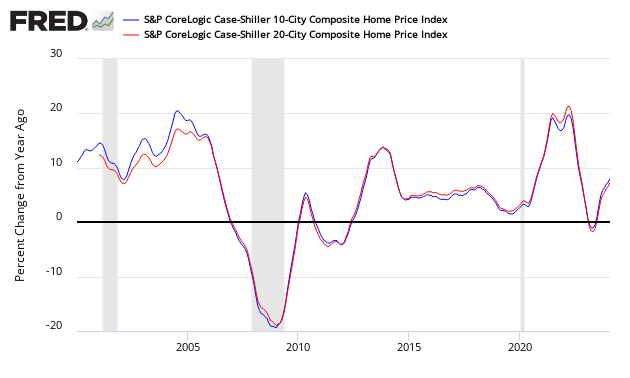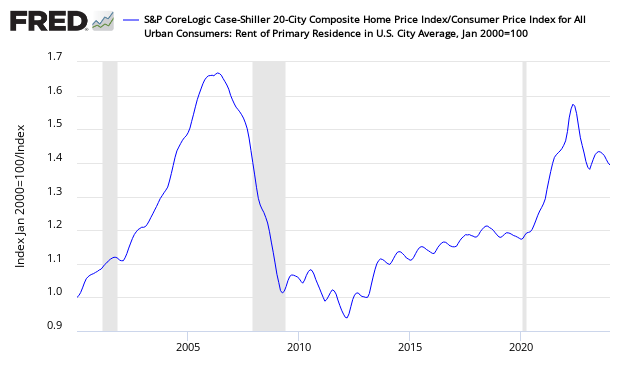Case-Shiller Home Price Index September 2015 Improves. Are We In A Housing Price Bubble?
The non-seasonally adjusted Case-Shiller home price index (20 cities) year-over-year rate of home price growth was 5.5 %. The authors of the index ask whether "the strength seen in home prices since the bottom in 2012 led some to wonder if we're entering a new bubble".

- 20 city unadjusted home price rate of growth accelerated 0.3 % month-over-month. [Econintersect uses the change in year-over-year growth from month-to-month to calculate the change in rate of growth]
- CoreLogic currently shows the highest year-over-year growth of 6.4 %.
- The market expected:
| Consensus Range | Consensus | Actual | |
| 20-city, SA - M/M | 0.1 % to 0.7 % | 0.3 % | +0.6 % |
| 20-city, NSA - Y/Y | 5.1 % to 5.6 % | 5.3 % | +5.5 % |
S&P/Case-Shiller Home Price Indices Year-over-Year Change

Comparing all the home price indices, it needs to be understood each of the indices uses a unique methodology in compiling their index - and no index is perfect. The National Association of Realtors normally shows exaggerated movements which likely is due to inclusion of more higher value homes.
Comparison of Home Price Indices - Case-Shiller 3 Month Average (blue line, left axis), CoreLogic (green line, left axis) and National Association of Realtors 3 Month Average (red line, right axis)
z existing3.PNG
The way to understand the dynamics of home prices is to watch the direction of the rate of change. Here home price growth generally appears to be stabilizing (rate of growth not rising or falling).
Year-over-Year Price Change Home Price Indices - Case-Shiller 3 Month Average (blue bar), CoreLogic (yellow bar) and National Association of Realtors 3 Month Average (red bar)
z existing5.PNG
There are some differences between the indices on the rate of "recovery" of home prices.
A synopsis of Authors of the Leading Indices:
Case Shiller's David M. Blitzer, Chairman of the Index Committee at S&P Indices:
Home prices and housing continue to show strength with home prices rising at more than double the rate of inflation. The general economy appeared to slow slightly earlier in the fall, but is now showing renewed strength. With unemployment at 5% and hints of higher inflation in the CPI, most analysts expect the Federal Reserve to raise its Fed Funds target range to 25 to 50 basis points, the first increase since 2006. While this will make news, it is not likely to push mortgage rates far above the recent level of 4% on 30 year conventional loans. In the last year, mortgage rates have moved in a narrow range as home prices have risen; it will take much more from the Fed to slow home price gains.
The strength seen in home prices since the bottom in 2012 led some to wonder if we're entering a new bubble. While bubbles can only be reliably identified in hindsight, one useful measure compares the increase in home prices to the change in rents. The first chart below shows the year-over-year change in the S&P/Case-Shiller National Home Price Index and the year-overyear change in the rent of primary residence series reported as part of the Consumer Price Index. Home prices are far more volatile. At the same time, the most recent data do not show a huge spread between the two series.

Another question raised by consistent real (or inflation adjusted) home price increases is whether the prices are squeezing people out of the market. One measure of affordability is based on median income, median home price, and mortgage rate; a value of 100 on the chart below indicates a home buyer at the median income can afford the median price home. As shown on the chart, affordability is more than adequate for a median income buyer now but has slipped a bit recently."

CoreLogic believes low inventories are spurring rising home prices (September Data). Per Sam Khater, deputy chief economist for CoreLogic and Anand Nallathambi, president and CEO of CoreLogic:
After nearly 10 years of very high home price volatility, home price increases have been remarkably stable for the last 15 months, ranging between a 4.8 percent and 6.5 percent year-over-year increase. Home price volatility is now back to the long-term trend prior to the boom and bust which is a good barometer of the market's stability and health.
The continued growth in home prices is welcome news for many homeowners but more markets are becoming overvalued. In the near term, this trend is likely to continue and pose evaluated risks to the housing economy. More has to be done to expand inventories if we are going to address the emerging affordability crisis, especially in hot markets like California and Colorado.
The National Association of Realtors says home sales prices have moderated(October 2015 data):
Lawrence Yun, NAR chief economist, says a sales cooldown in October was likely given the pullback in contract signings the last couple of months. "New and existing-home supply has struggled to improve so far this fall, leading to few choices for buyers and no easement of the ongoing affordability concerns still prevalent in some markets," he said. "Furthermore, the mixed signals of slowing economic growth and volatility in the financial markets slightly tempered demand and contributed to the decreasing pace of sales."
Adds Yun, "As long as solid job creation continues, a gradual easing of credit standards even with moderately higher mortgage rates should support steady demand and sales continuing to rise above a year ago."
"All-cash and investor sales are still somewhat elevated historically despite the diminishing number of distressed properties," adds Yun. "With supply already meager at the lower-end of the price range, competition from these buyers only adds to the list of obstacles in the path for first-time buyers trying to reach the market."
NAR President Tom Salomone says Realtors® overwhelmingly applaud the Federal Housing Administration's announced changes to begin simplifying some of its overly-restrictive condo certification procedures. "With first-time buyers held back in several markets, affordable FHA financing needs to be a viable option in helping them achieve homeownership," he said. "The new changes to FHA's condo policy, including improving owner-occupancy requirements, streamlining the recertification process, and addressing restrictions on eligible property insurance for condos will go a long way in improving the ability for these young households to purchase a condo."
Black Knight Financial Services (formerly known as Lender Processing Services)August 2015 home price index up 0.3 % for the Month; Up 5.5% Year-over-Year.

Econintersect publishes knowledgeable views of the housing market.
Caveats on the Use of Home Price Indices
The housing price decline seen since 2005 varies by zip code - and seems to have ended somewhere around the beginning of the 2Q2012. Every area of the country has differing characteristics. Since January 2006, the housing declines in Charlotte and Denver are well less than 10%, while Las Vegas home prices had declined almost 60%.
Each home price index uses a different methodology - and this creates slightly different answers. There is some evidence in various home price indices that home prices are beginning to stabilize - the evidence is also in this post. Please see the post Economic Headwinds from Real Estate Moderate.
The most broadly based index is the US Federal Housing Finance Agency's House Price Index (HPI) - a quarterly broad measure of the movement of single-family house prices. This index is a weighted, repeat-sales index on the same properties in 363 metro centers, compared to the 20 cities Case-Shiller.
The US Federal Housing Finance Agency also has an index (HPIPONM226S) based on 6,000,000 same home sales - a much broader index than Case-Shiller. Also, there is a big difference between home prices and owner's equity (OEHRENWBSHNO) which has been included on the graph below.
Comparing Various Home Price Indices to Owner's Equity (blue line)


With rents increasing and home prices declining - the affordability factor favoring rental vs owning is reversing. Rising rents are shifting the balance.
Price to Rent Ratio - Indexed on January 2000 - Based on Case-Shiller 20 cities index ratio to CPI Rent Index

Disclosure: None.





